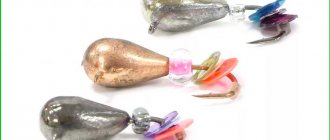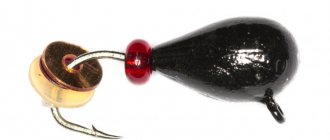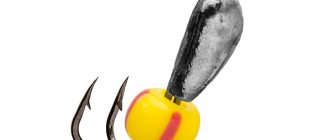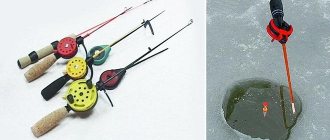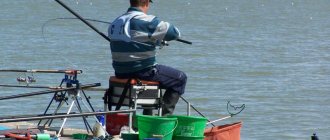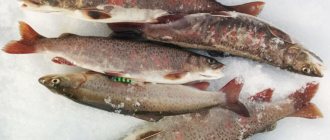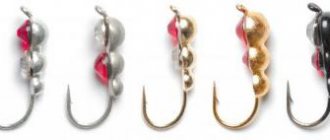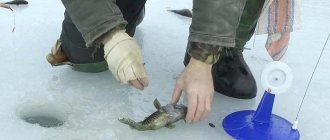The nozzle-less jig "Cat's Eye" appeared relatively recently and quickly gained popularity among anglers. People call it “Nailball”. It is a winter jig with a mother-of-pearl bead on a hook, which in the dark looks like a glowing cat's eye. In the video we will look at fishing techniques and real experience of using gear on reservoirs. Here you can find detailed instructions on how to make this jig with your own hands, as well as how to tie it to a fishing line.
At the end of the article there are reviews and links to online stores where you can buy these fishing lures in different colors and sizes.
Features of the “cat's eye”
“Cat's eye” is a jig used without a nozzle - without a reel. The shape of the bait resembles a mormysh, which is the main food source for almost all types of fish both in winter and summer. The bait is the body of the jig, most often painted black and a large bead located on the hook.
The bead can have different colors and also slides freely along the hook. There is an option in which the sliding of the bead is limited by a cambric worn closer to the sting. The bead can be attached to the hook directly through the hole in its center, or attached to it using a loop at the top of the bead.
Even during periods when the fish are not active, you are unlikely to leave the pond empty-handed. A wide variety of fish can be caught with this tackle, and the color of the bead plays an important role in this:
- Ide, roach and roach prefer green shades of beads.
- Orange and yellow ones are best for perch.
- White and beige ones are most likely to attract bream.
Design Features
Most often, as already mentioned, the cat's eye is made on the basis of cloves. However, this is not a rule. Any jig shape can be used. And the rewinder is equipped with a large ball, directly on the hook or through a wire. It’s just that these jigs in the shape of a nail ball are more often found on sale. However, there are also other types of mothless ones equipped with a similar pebble - uralki, droplets, oatmeal and even little devils.
Eye on the goat
The whole secret is in the bead
So, the body of the jig can be anything. The features of this jig are determined by the pendant - a special large bead on the hook (and not only in the shape of a ball). The following distinctive features are observed on the “correct” cat’s eye:
- The pendant (ball, cube) has an optical property - an iridescent stripe. This means that the bead has a clearly visible translucent dark part that changes when rotated. A number of stones have this feature - quartz, ruby, tourmaline and others. Naturally, no one makes jigs from such materials. Borosilicate glass beads with a similar optical effect are used. This iridescent stripe is an irritant for fish, especially when fishing at shallow depths, in clear water and in sunny weather.

- The bead moves freely along the hook without flying off due to the bend of the fore-end. Thanks to this, when playing, the ball taps against the body of the jig, which also attracts fish. All nail balls are made according to this principle. This effect is possible only if the “eye” is put on the hook through the hole, and not attached to a wire. On the correct nail ball, the bead hole is quite large in diameter. Thanks to this, the fit of the bead to the body of the bait is greater, and the knock is more obvious.
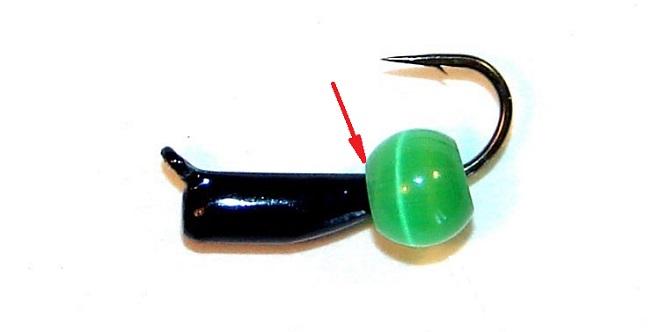
Correct Cat's Eye - bead with a large hole, relatively large hook - The color of the ball is experimental. Some fishermen call the cat's eye a reelless fish with a bead of a characteristic green color. However, in reality there are many flowers. Any shades, from white to black. The main thing is that there is an iridescent stripe. For example, a vigorous eye jig is the same thing, just a ball of bright acid color is used (by the way, a working solution for muddy water and poor visibility conditions). Green color works well for roach and ide, white and milky for bream. Perch prefers yellow and orange shades. Of course, this is just a general trend. The tastes of fish in different bodies of water differ.
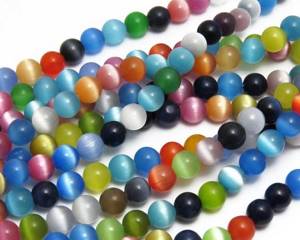
- The weight of a glass bead is less than that of a brass ball. Therefore, a cat's eye rewinder and a nail ball with a brass (bronze) bead play differently. There is an opinion circulating online that this bait is for shallow water. However, this reelless bait fishes well at depth, especially in the dead of winter with a slow, monotonous game with a knock.
Choosing a rewinder
Finding a cat's eye mothless is not a problem now. Many fishing stores sell such reelless baits. However, due to the trend hype, low-quality products are found on the shelves. Before purchasing, it is better to carefully inspect each model, touch it with your hands, and check the amplitude of movement of the ball along the fore-end. Nizhny Novgorod cat's eye jigs, products from the Ulovka company, and Dzerzhinsk rewinders are popular.
You can also make a cat's eye bait yourself. At the same time, it is important to comply with the requirements described above - then such a homemade rewinder will really work due to the listed advantages (knock, glare, color of the ball).
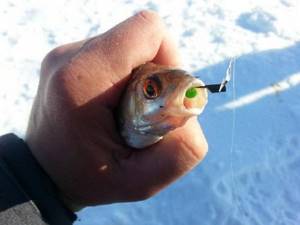
DIY "Cat's Eye"
For those who prefer to make such gear themselves, we offer step-by-step instructions:
- Take any reelless jig, for example, nail balls.
- A bead of the required size and color is selected.
- Using a thin drill, make two holes next to each other.
- We make a bracket from a wire of suitable diameter and insert it into the drilled holes, passing a hook through it in advance;
- On the reverse side we secure the ends of the wire with superglue.
- We tidy up the joints and remove any remaining glue.
- In order to avoid slipping, we place a cambric next to the sting.
Video about making a reelless jig with your own hands:
The homemade “Cat's Eye” is ready, all you have to do is test it on a pond!
Making a jig with your own hands
To work you will need:
- pliers;
- side cutters;
- personal and velvet files;
- a set of needles of different sizes;
- glue;
- soldering iron
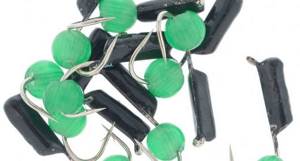
Step-by-step instruction
- Another tool may be needed, it all depends on what method we will use to create the bait. And a lot depends on the materials when doing this work. Sheets of lead, hooks of the required number, pieces of sheet copper, stainless steel, bronze and silver will be useful for this. Having collected all the components, we begin to make the jig using the sawing method.
- Using a metal saw or a chisel, we make the required workpiece according to the markings. Depending on the size and type of fish, we take the appropriate hook. Most often, No. 4 is installed.
- We solder the hook to our blank with lead. If lighter tackle is needed, solder with tin. Now we process all the irregularities and burrs with a needle file until the surface is smooth.
- We shape the workpiece with pliers and polish it using fine sandpaper and a velvet cloth with Goya paste. Now we need to decorate it.
- We securely attach the bead to the hook with wire. We insert a wire into the hole of the bead and insert a hook into the loop from it and fill the hole with waterproof glue without voids. We remove the edges of the wire with side cutters and clean this place.
- Place a piece of plastic tube near the sharp edge. With its help we will regulate the depth of fishing. If a bead of the desired shape is not found, we use another method.
- From a tube of silicone we put a drop of material on any oblong metal object, for example, a thin knitting needle. And, holding it over a scattered fire, we dry it and give the workpiece the shape of a circle.
- Just like in the first case, we do the final assembly of our catchable bait. Well, now all that remains is to wait until the day off to enjoy seeing the result of your labor.
How to tie a jig
There are many knots for tying a jig. Let's look at the baits we need, tied in the ear:
- Figure eight knot. First, a fishing line is threaded into the eye of the bait, a loop is made from the fishing line and, holding the loop, at the bottom we make at least 4 turns with the free end of the fishing line and tighten the knot.
- Clinch knot. It is knitted like this, the line also passes through the ring, there will be a line in your hand, going to the end of the fishing rod. We wrap the free end around the line pressed to the bait and then pass the end into the eye and tighten the knot.
- Simple knot. We make a loop with the edges of the line crossing at the bottom, and now we wrap the line inside the loop, then fasten the knot and move it along the line to the knot, it should not go into the eye, otherwise we will lose our favorite jig. You need to pay attention to the ear. It should not have burrs or sharp edges.
Fishing technique
Based on the fact that the “Cat’s Eye” jig is reelless, the type of wiring used is selected. If the fish is not active, the movement of the jig will be slow, there will be more pauses, and the amplitude will increase. If the fish is active, the wiring will be aggressive, with a small amplitude and the pauses will become shorter.
It is believed that this jig owes its catchability to the play of light in the translucent bead, as well as to the knocking effect that occurs during retrieving. The tackle sways and the ball moves along the hook, making a knocking sound.
The jig performs best in shallow water; due to its light weight, it works well with slow retrieves. But low weight is also a disadvantage when fishing in the current; difficulties arise in delivering the bait to the bottom.
The following video shows very clearly the features of playing with a jig, as well as the results that this bait gives.
Tips and Tricks
Fishing for "cat's eye" is carried out in winter. For fishing, it is best to use aggressive wiring: small amplitudes and short pauses in the wiring. This method is effective for active fish. If the fish is passive, it is worth increasing both the duration of the pauses and the amplitude of the retrieve when fishing. But not only the activity of the fish affects the wiring. It also depends on the type of fish. For example, perch prefers a fast retrieve, while bream prefers a leisurely, relaxed retrieve.
For fishing with this tackle, a 0.6 mm fishing line is best suited. With this line you can catch fish weighing up to one kilogram. Due to this size, the jig swings up and down when playing, but swinging to the sides becomes difficult.
Cat's Eye has different bead colors and each color is used to catch a specific fish.
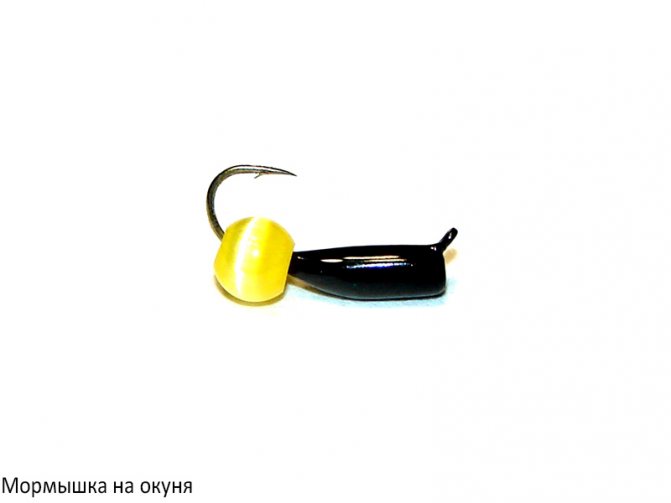
Below is a table that will help you choose the color of the bead.
| Bead color | Fish |
| Green | Ide, roach, sorog |
| Yellow and orange | Perch |
| White and beige | Bream |
This table is not a final guideline for choosing, since the “cat’s eye” jig is a relatively new jig. If you give free rein to your imagination and experiment a little, you may find other patterns.
Features of the bait
The “Cat's Eye” jig is used without an attachment and is reelless. Its shape resembles a mormysh, which is a food source for various individuals. A bright bead of various colors clings to the edge and slides freely along the hook. In some modifications, sliding is limited by the cambric at the sting.
fish with this bait both in summer and winter. Even during a period of relative passivity, you can get a good catch, among which you can catch the following individuals:
- Ide, roach, roach (caught with a green bead),
- Perch and similar fish (catch with orange and yellow baits),
- It is preferable to catch bream and bream using white and beige jigs.
These are the main features that are inherent in this fishing element and can help in catching various types of fish. Next, we’ll look at how you can make a “Cat’s Eye” with your own hands.
Nailball family
Most often, a cat's eye is found in the form of a nail ball. This group of baits are good old posts (cloves) with a large bead on the hook. The main feature is the knocking of this bead on the body of the rewinder during the game. However, the name did not appear from a specific body shape of the bait. The peculiarity of this class of baits is the bead itself. It is the characteristics of the bead that determine its belonging to this name.
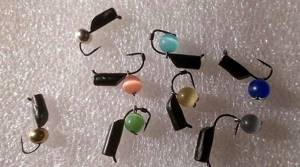
Methods for making a cat's eye jig
Material

There are various options for cat eye rigging that you can create yourself.
Basically you will need:
- lead;
- hooks;
- beads or a piece of colored silicone;
- wire and more.
In this case, you also need to pay attention to what kind of “cat’s eye” jig you decided to make.
There are several ways to create a cat's eye rig, which differ in speed and methods of performing the work.
Pouring out

Pouring is considered the least labor-intensive process for making such equipment, the main material for which is useful: small pieces of copper, brass, stainless steel, bronze and silver.
Main stages of work:
- It is recommended to use a metal file to give the workpiece the required shape. Moreover, be sure to process the edges with a fine file and sandpaper.
- Then it is recommended to take a previously prepared hook (preferably no more than No. 4) and solder it to the plate.
- If the eye of the hook is filled with solder, you need to make a hole using a drill.
- Using pliers, give the workpiece the correct shape.
- To slightly increase the weight of homemade gear, you can additionally use lead by dropping it on the inside of the product. Ready!
Forging
Using the forging method, you can create tackle from lead. It will serve you for a long time, as it is distinguished by its durability.
Step-by-step instructions for creating a jig using the forging method
- Having placed the workpiece on the anvil, give it the required shape, making sure to process it around the circumference with a file and a needle file.
- Next, you need to prepare the hook. To do this, his ear is bitten off and the fore-end is cleaned.
- After carefully treating the workpiece with soldering acid, make a small depression in the lead.
- Place the forend in the previously made recess and seal it with tin.
- After doing some minor cosmetic work, you can use a jig you made yourself.
Soldering
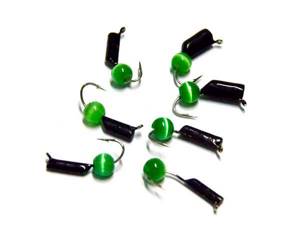
Using the soldering method, it is possible to create a “cat’s eye” from thin sheet metal (foil) by folding it. A hook is inserted into the hole and everything is soldered.
Some fishermen additionally, before starting to create the cat's eye gear, make some design by rolling a screw across the sheet metal. Moreover, the solder completely fills the mold. All excess is removed so that all turns of wire are visible without exception.
Casting
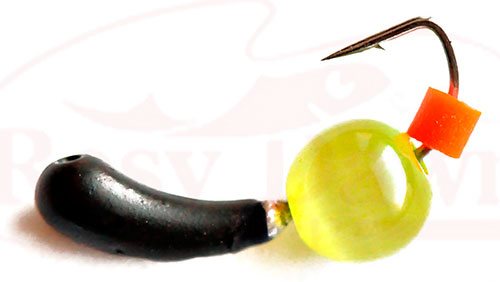
Using the casting method you will get the highest quality fishing tackle. But it will take enough time and labor. There are a huge number of recommendations in this matter. We will consider the most popular option. To create a plaster mold, you must use sweetened water.
Moreover, at the final stage, the workpiece is dried for several days. You can also purchase aluminum molds at a specialty store, but there are simpler casting methods.
For example, the following:
1. In wooden blocks. 1.1 Having prepared two units of not very large wooden blocks, create a bait-shaped recess in them so that by putting them together you get a tackle. 1.2 In the resulting blanks it is necessary to make a recess for the hook and a hole into which lead will be poured in the future. 1.3 Carefully insert the hook and attach the bars tightly to each other. 1.4 Begin to carefully pour metal, heated to the desired liquid state, into the hole. 1.5 Wait until the product cools completely and process it with a needle file. 1.6 Finally, make a hole for the fishing line and you're done.
2. In the sand. 2.1 First, you should create a “cat’s eye” layout. 2.2 Wrap the resulting workpiece in thin foil and dip it in damp sand. 2.3 Then you need to take out the mold and fill it with lead. 2.4 The hook is inserted into the metal and remains in it until it cools completely. 2.5 At the final stage, it is necessary to carefully process the “cat’s eye”, paying special attention to the place where the hook is attached.
Tips and reviews from owners
Excellent fishing in shallow water, and it’s best to take a brass ball.”
Grade:
Danila
“This bait is perfect for passive perch. He even boasted of captured specimens.”
Grade:
Alexei
“The main advantage of such a jig is the creation of a kind of glare of the ball, its bright iridescent stripe, cannot leave the predator indifferent. And the ball itself moves on the hook with a good thud.”
Grade:
DENBOX
“In case of bad fishing without bait, you can try combining it with maggot (red or white) or jig (boiled or live). It will be effective both for perch and for catching trout. I have green and black with a red stripe, but preferably use the regular black one. Beads must be white for everyone. Overall a great attachment."
Grade:
LionKinda
“There are some good jigs that shoot at roaches. I rarely fish with it, but this tackle catches.”
We suggest you familiarize yourself with: Balancers for pike perch
Grade:
Den2907
Tips for creating a cat eye:
- There is a relationship between the size of the catch and the weight of the bait. The more accurately and carefully the fish bites, the less heavy the jig should be;
- to create a heavy bait, it is necessary to give preference to hard metal alloys;
- special attention should be paid to the shape of the newly created jig. It should most accurately imitate the behavior of food;
- if the hook is poorly soldered, the hooking will be unreliable;
- most fishermen recommend using a single-core hook;
- Creating a cat's eye tackle will not take much time, but will significantly save your money.
